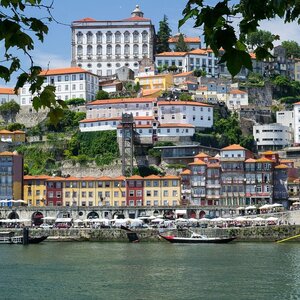I just got back from Barcelona… here’s what I think you should know
From the twisted and dark alleyways of the Gothic Quarter to Gaudi’s shimmering, fairytale buildings and to the green hills of Montjuïc, Barcelona is sitting pretty as one of Europe’s greatest cities. No Spanish adventure would be complete without a stop here.
In June, I spent two weeks in Barcelona with some friends and family. Each day of the trip followed a similar pattern: wandering around markets, beaches, and museums and then eating, drinking wine, and eating some more. In other words, a perfect summer city break.
What part of the city did you stay in? What was the vibe?
I stayed in Gràcia, a creative, tree-lined neighborhood known for its independent bookshops, theaters, sustainable clothing boutiques, coffee shops, and wine bars. It’s family and dog-friendly and slightly more residential than the heavily-touristed areas of Barri Gòtic and La Barceloneta (though it’s well-connected to these neighborhoods, and indeed to most of Barcelona, through the city’s excellent public transport network).
Top neighborhoods to explore in Barcelona
Barcelona caters to foodies of all stripes © Alexander Spatari
What I love most about Gràcia is its public squares. They’re always packed with locals and visitors, but the vibe is always relaxed; nothing is hurried. People spend hours on the terraces of bars and restaurants, savoring meals and people-watching. My favorite in Gràcia is the lively Plaça de la Virreina. Sitting there in the evening (tables start to fill up at about 7 pm) over a glass of vermouth is undoubtedly one of the most delightful ways to get into the swing of life in Barcelona.
How did you get around?
Barcelona is an easy city to navigate, so I walked most places, but the metro and bus network is exceptional and will bring you all over the city. I recommend purchasing a T-Casual ticket if visiting. It gives you 10 journeys on both the metro and bus for €11.35 (£9.80, US$11.90), and it’s much cheaper than paying for a single trip (€2.40, £2, US$2.50) each time.
Starting September, it will become even cheaper to travel around Barcelona when the city cuts public transport fares in response to the cost of living crisis. The T-Casual 10-trip pass will cost €5.70 (£4.90, US$5.90) and a single journey ticket will cost just €1.20 (£1, US$1.25).
How much does a cup of coffee cost at a local coffee shop?
In the third- and fourth-wave coffee shops, prices are typically high for Barcelona, where an oat flat white cost me about €3.20. In the less-flashier traditional bar-cafeterias, there are more budget-friendly options. You won’t find flat whites there, but you’ll generally get an excellent espresso (cafè sol) for about €1.20. These bars are also great places to get a quick and reasonably priced breakfast. Tip: order a bikini (toasted cheese sandwich), and with your espresso, that’s a satisfying breakfast sorted for under a fiver.
From cheap market eats to high-end restaurants, Barcelona caters to diners of all stripes © Sasha Brady / Lonely Planet
What did you book in advance of your trip?
Dinner. Barcelona is one of Spain’s top culinary destinations for foodies of all tastes. But when it comes to securing a table at a popular restaurant, by and large, you can’t just roll up without notice. It’s not that the dining scene is exclusive; it just takes some planning, especially in high season.
On this trip, some of the restaurants on my wishlist included Bar Cañete, COME by Paco Méndez, Taberna Noroeste, and Disfrutar. All required prior bookings. If you’re planning a trip to Barcelona, you should call the restaurant you wish to visit at least a week in advance. With some casual places, you might get lucky with same-day bookings.
In terms of COVID-19, did you encounter restrictions?
In Barcelona, like the rest of Spain, face masks are still required on public transport. That means you must wear one when on a bus, train, metro, in a taxi or while waiting in a station. You’ll also need one at the airport and on your flight to and from Spain. It’s a rule that Catalans took very seriously when I was there, but it was frustrating to see that many tourists didn’t.
The face mask rule will be in place for the rest of the summer as Spain is in the middle of another coronavirus wave. You could be fined or refused access if you don’t wear a mask on public transport while the rule is in place. The health ministry is also recommending that masks are worn in busy indoor public spaces until the current wave eases.
The village of Sant Pol de Mar has beaches that feel much calmer than Barcelona’s © Getty Images/iStockphoto
I got away from the crowds by…
Visiting beaches outside of the city. Barcelona’s beaches are lovely, but they’re always busy in summer, particularly La Barceloneta beach. But if you get the R1 train north from Arc de Triomf or Plaça de Catalunya stations, you’ll have more choices of beaches with fewer crowds. The train runs along the Marseme coast with seaside stops to beaches that can feel light years away from the bustle of Barcelona. The trains reach most shores in under an hour like Montgat (about 25 minutes) but my favorites, Sant Pol de Mar and Caldes d’Estrac, are just over an hour away.
Similarly, you can take the R2 or R2 Sud from Barcelona Sants, Barcelona Passeig de Gracia, or Barcelona Estacio de Francia stations to the beaches of the south including the beaches of Castelldefels and Sitges.
Saturday afternoons in Gràcia © Sasha Brady / Lonely Planet
Best tips for someone who wants to plan the same trip?
Barcelona’s problems with overtourism are well documented. I was there at a hectic time in June as Primavera music festival was on at the same time as Barcelona’s design festival. Most places, especially along the beaches, the tourist sites, and the warren of narrow streets in Ciutat Vella, were thronged with tourists. It can be overwhelming, especially for the people who live there, but there are some things visitors can do to keep the adverse effects of tourism in check, such as…
Don’t treat the city like a beach. Barcelona has strict rules regarding beach attire; you can’t walk the city streets shirtless or wear a swimsuit, bikini, or bathing trunks unless you want to run the risk of landing a €300 fine.
When booking accommodation, try to use registered hotels and b&bs. If booking an Airbnb, make sure it’s licensed.
Buy local, including at local stores and markets. What I love about Spanish cities is that you’ll find many specialty stores where you can buy unique, thoughtful, and well-made pieces. Even in a big city like Barcelona, you’ll have no trouble finding these stores once you step away from the high-street and high-end shopping districts of Plaça de Catalunya and Passeig de Gracia.
When venturing into the city, try to get your bearings before hitting a busy spot. Often, I saw groups of tourists crowding around ticket machines in metro stations while they figured out how to use them, blocking access for locals who were forced to queue for a long time behind them. It was also common to see groups of tourists stopping at the entrances and exits to metro stations while they consulted maps on their phones to figure out their next step, prompting frustrated locals, seemingly in a rush to get home or to work, to awkwardly step around them or ask them to move.
Book tours in advance because group walking tours are now capped to a maximum of 30 people or 15 in Ciutat Vella to reduce crowding and noise pollution. Group visits to some historic attractions have also been capped to three or eight visitors at a time so spaces fill up quickly.
Finally, it’s good to have some basic Catalan phrases to hand. You’ll get by with English and Castilian but a bon dia (hello), gràcies/merci (thank you), or sil us plau (please) goes a long way when chatting with locals.










